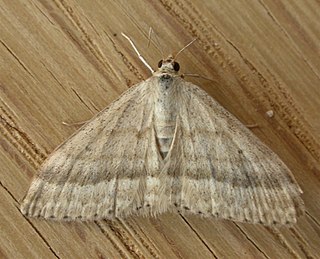
The geometer moths are moths belonging to the family Geometridae of the insect order Lepidoptera, the moths and butterflies. Their scientific name derives from the Ancient Greek geo γη or γαια "the earth" and metron μέτρων "measure" in reference to the way their larvae, or inchworms, appear to "measure the earth" as they move along in a looping fashion. A very large family, it has around 23,000 species of moths described, and over 1400 species from six subfamilies indigenous to North America alone. A well-known member is the peppered moth, Biston betularia, which has been subject of numerous studies in population genetics. Several other geometer moths are notorious pests.

Ennominae is the largest subfamily of the geometer moth family (Geometridae) with some 9,700 described species in 1,100 genera. They are usually a fairly small moths, though some grow to be considerably large. This subfamily has a global distribution. It includes some species that are notorious defoliating pests. The subfamily was first described by Philogène Auguste Joseph Duponchel in 1845.

The Cidariini are the largest tribe of geometer moths in the subfamily Larentiinae. The Cidariini include many of the species known as "carpets" or, ambiguously, "carpet moths", and are among the few geometer moths that have been subject to fairly comprehensive cladistic study of their phylogeny. The tribe was described by Philogène Auguste Joseph Duponchel in 1845.

Scopula decorata, the middle lace border, is a moth of the family Geometridae. It is found throughout Europe.

Scopula immorata, the Lewes wave, is a moth of the family Geometridae. It is found throughout Europe and the Near East.

Scopula nigropunctata, the sub-angled wave, is a moth of the family Geometridae. It is found through most of the Palearctic ecozone.

Scopula lydia is a species of moth of the family Geometridae. It was described by Arthur Gardiner Butler in 1886. It is endemic to Australia.

Sterrhinae is a large subfamily of geometer moths with some 2,800 described species. This subfamily was described by Edward Meyrick in 1892.

Scopulini is a tribe of the geometer moth family (Geometridae), with about 900 species in seven genera. The tribe was described by Philogène Auguste Joseph Duponchel in 1845.
Louis Beethoven Prout (1864–1943) was an English entomologist and musicologist.
Scopula apparitaria is a moth of the family Geometridae. It was described by Francis Walker in 1861. It is found in South and Central America, the Greater Antilles and Florida. The type location is Honduras.
Scopula subpunctaria is a moth of the family Geometridae. It is found from northern and north-eastern China to the southern Palaearctic ecozone.
Scopula beckeraria is a moth of the family Geometridae. It was described by Lederer in 1853. It is found in Italy, Croatia, North Macedonia, Greece, Bulgaria, Romania, Ukraine, Russia, Turkey, Armenia, Israel, Lebanon, Iran, Turkmenistan and Kazakhstan.

Scopula curvimargo is a moth of the family Geometridae. It is found in Kenya, South Africa, Tanzania, Zambia and Zimbabwe.
Scopula impersonata is a moth of the family Geometridae. It is found in China, the Russian Far East, Taiwan and Japan.
Scopula latitans is a moth of the family Geometridae. It is found in Angola, the Democratic Republic of Congo, Guinea, Kenya, Malawi, South Africa, Tanzania, Gambia and Zimbabwe.
Scopula macrocelis is a moth of the family Geometridae. It is found in the Republic of Congo and Cameroon.

Scopula nemoraria is a moth of the family Geometridae. It is found from central to eastern Europe, east to Russia and China.

Scopula relictata is a moth of the family Geometridae. It is found in Kenya, Senegal, the United Arab Emirates, Australia, India, Sri Lanka and Taiwan.
Scopula caricaria is a moth of the family Geometridae. It is found in Spain, Italy, France, Liechtenstein, Germany, Austria, Switzerland, Poland, the Czech Republic, Slovakia, Hungary, Romania, Slovenia, Croatia, Bosnia and Herzegovina, Finland, Estonia, Latvia, north-western Russia, Belarus and Ukraine.












